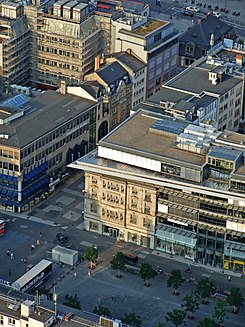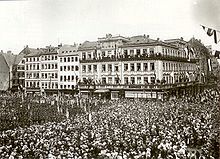Steinweg (Frankfurt am Main)
| Steinweg | |
|---|---|
| Street in Frankfurt am Main | |
| Short way between two places | |
| Basic data | |
| place | Frankfurt am Main |
| District | Downtown |
| Created | around 1333 |
| Newly designed | 1954 |
| Connecting roads | Goethestrasse (west), Zeil (east) |
| Places | At the Hauptwache , Goetheplatz |
| Buildings | Hotel zum Schwan (†), Hotel Weidenbusch (†), Mousonhaus (†) |
| use | |
| User groups | Pedestrian zone |
| Technical specifications | |
| Street length | 70 m |
The stone path is a shopping street in the city of Frankfurt am Main . It connects the central square of the city center, the Hauptwache , with Goetheplatz to the west of it . It has been designated as a pedestrian zone since the early 1970s .
Surname
The Steinweg got this name after the city expansion approved by Emperor Ludwig the Bavarian in 1333 , when the area previously outside the densely populated old town was enclosed with a new city wall. The Steinweg is mentioned for the first time in 1341. The path led in the direction of Bockenheim and was given this name because it was one of the first cobbled streets in medieval Frankfurt.
location
The Steinweg is mentioned for the first time in a council ordinance of September 30, 1421, in which the council forbade citizens to keep their pigs on the open street because this would damage the streets and the residents. They were only allowed to be driven across the streets to drink or feed.
The important connection from the Katharinenpforte , one of the three gates leading through the Staufen wall into the old town , led over the Steinweg to the two western city gates: over the Große Bockenheimer Gasse to the Bockenheimer Tor and over the Roßmarkt and the Große Gallusgasse to the Galgentor .
From 1872 to 1954 the Frankfurt tram used the Steinweg before the route was moved to the parallel Biebergasse . Today there is access to the Hauptwache underground station in Steinweg .
The street scene is dominated by the tower of the Katharinenkirche at the Hauptwache, which is exactly in the line of sight of the Steinweg.
The range of retail outlets on Steinweg is, on average, somewhat higher quality than that on the neighboring Zeil to the east ; the western continuation of Steinweg, Goethestrasse , is the city's most expensive shopping street.
Important buildings
Hotel to the swan
Main article: Hotel zum Schwan
The noble Hotel zum Schwan stood on the north side of the street on the corner of Goetheplatz until it was destroyed in the war in the air raids on Frankfurt am Main in 1944 .
The house Zum Weißen Schwan in Steinweg was first mentioned in a document in 1371. From 1592 it served as an inn. In 1791 the hotelier Jacob Fay had the swan and the two adjacent buildings demolished and a new building built in the classical style. The hotel with its 150 beds became the most prestigious quarter in Frankfurt and counted many prominent guests. Literary monuments were placed on the swan in 1826 by Wilhelm Hauff (communications from the memoirs of Satan) and in 1827 by Ludwig Börne (The Fool in the White Swan) . In 1831 the swan was modernized. In addition to a new dining room with a monumental ceiling painting, it was one of the first houses in Frankfurt to receive gas lighting .
On May 10, 1871, Chancellor Otto von Bismarck and French Foreign Minister Jules Favre signed the Peace of Frankfurt between France and the newly founded German Reich in the Hotel zum Schwan . The "Peace Room", in which the signing took place, was never rented afterwards.
At the end of the 19th century, the swan was subject to competition from the newly opened large hotels such as the Frankfurter Hof . In 1907 the hotel was rebuilt again, but it was closed in 1919. The hotel was converted into a cinema and office building. The building was destroyed in the bombing war in 1944.
In 1949 the building was rebuilt in a modern way by the architects Alois Giefer and Hermann Mäckler . In the post-war decades there were several cinemas here, first since 1954 the Metro im Schwan, later the Bambi and in 1967 the Palette . In the 1970s, three small cinemas (Metro 2-4) were also set up. In 1987 the cinemas moved out and the building was converted into a book store (a branch of the Hugendubel bookstore chain ).
Hotel Weidenbusch
Another well-known inn was the Hotel Weidenbusch , located opposite the Hotel Zum Schwan on the corner of Steinweg and the narrow Töpfgasse . The Töpfgasse, which no longer exists today, was built in 1666 when the council erected a narrow row of similar terraced houses , the so-called New Houses, on the Roßmarkt . It got its name from the flying stalls for pottery from the Kannenbäckerland and Franconia that used to be located here .
The Weidenbusch has been mentioned as an inn since the beginning of the 18th century, but its ascent did not begin until around 1770, when Johann Martin Mohr had a new late-baroque building built for 400 guests. The large dining room could accommodate over 1000 people. From 1832 to 1860 it served the Frankfurt Museum Society as a concert hall, in which famous artists such as Hector Berlioz , Felix Mendelssohn Bartholdy , Niccolò Paganini , Henri Vieuxtemps , Clara Schumann and Richard Wagner performed. Public banquets were also held in the Weidenbusch Hall, including a celebration for Goethe's 70th birthday in 1819, organized by the banker Willemer .
During the Frankfurt National Assembly , the imperial -minded members of the center- right met in the Weidenbusch before major votes. B. on the Greater German solution or the election of the emperor .
Last but not least, the willow bush was also included in literature. For example, the poem Der Hausknecht in the “Weidenbusch” appeared in Wilhelm Busch's collection of poems Critique of the Heart , published in 1874 .
In 1859 the Hotel Weidenbusch was renamed Hotel de l'Union . In 1905 the old late baroque building was torn down and replaced by a magnificent new building. After it was destroyed by bombs in 1944, the willow bush was rebuilt in a simplified form and used as a commercial building. At the beginning of the 21st century, the Zum Weidenbusch building and its neighbors from the Wilhelminian era were torn down and replaced by a glass office building. The facade from 1907, which had remained standing under pressure from the monument authorities, was integrated into the new building. Today there is a fashion boutique in the building.
Mouson House
In 1949 the "Mousonhaus" was built on the corner of Steinweg and Hauptwache according to plans by Georg Scotti, a seven-story Bauhaus-style commercial building as one of the first new buildings after the war. In the 18th century there was a smithy here , later a commercial building, in the place of which a magnificent new building in Wilhelmine style was built in 1897. The Mousonhaus was demolished at the end of the 1990s and replaced by a new post-modern building.
literature
- Wolfgang Klötzer: Visiting the old Frankfurt , Heinrich Hugendubel-Verlag, Munich 1990, ISBN 3-88034-493-0
- Fried Lübbecke : The face of the city. Based on Frankfurt plans by Faber, Merian and Delkeskamp 1552–1864 , Verlag Waldemar Kramer, Frankfurt am Main 1983, ISBN 3-7829-0276-9
swell
- ↑ Stadtvermessungsamt Frankfurt am Main (ed.): Portal GeoInfo Frankfurt , city map
-
↑ The Rait is conceived and built
as a number of lude ire pigs in the statute and let them move in the alleys, which
do damage to the stone path and sunsthe light, that is
, the pigs who want to pull vnnd should
hold after martini nehstkompt [11. November 1421] in synem huse
or hoff vnd wonu [n] g, and in the stat nit let it run,
it was then that one
wanted to drive them to water or to dirt or for shepherds to field, one would like to
do that, and If you drive through
the lanes quickly, aries and fure. Wherever
pigs, young or old, are found in the alleyways, whether it be day
or night, the rait has ordered the crowd
at night and during the day with "A" and "B", which they should intribe
by eide and Nobody overlooked it, and one
shilling h [el] l [e] r from a real pig, big or small, is atoned for.
Actum in Crastino Michaelis, Anno XIIII c XXI [30. September 1421].
With the prescribed penalty sale one part of the rait and the
servants who intrude it, two parts.
Web links
- Steinweg and Hotel zum Schwan, around 1900
- Michael Matthäus: Frankfurt messes - pig farming in the old town. In: Newsletter 3, 03-2004. Institute for Urban History , archived from the original on October 28, 2007 ; accessed on January 24, 2018 .
- Around the Hauptwache - views of a square. (PDF file; 1.68 MB) Exhibition catalog of the Institute for Urban History from 2004. Institute for Urban History, archived from the original on September 27, 2007 ; accessed on January 24, 2018 .
Coordinates: 50 ° 6 ′ 48 ″ N , 8 ° 40 ′ 39 ″ E





